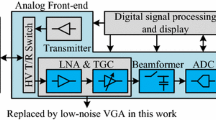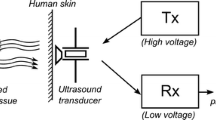Abstract
In this paper, an auto-tuning system using a variable synchronous switched capacitor is presented. This auto-tuning system is used for controlling the resonant frequency of the tank circuit of a half-bridge voltage-mode resonant converter for high intensity focused ultrasound applications. The proposed auto-tuning system is based on a switched capacitor instead of a large inductor in the classical tuning topology. Therefore, there is no need of bulky magnetic components, which makes it naturally compatible with the usage of a magnetic resonance imaging system nearby for monitoring. The circuit was designed in a CMOS 0.35 µm technology under a voltage supply of 5 V and for the working frequency of 1 MHz. Electrical simulations as well as post-layout simulations have been done and simulation results have confirmed the required performances.


























Similar content being viewed by others
References
Illing, R. O., et al. (2005). The safety and feasibility of extracorporeal high-intensity focused ultrasound (HIFU) for the treatment of liver and kidney tumours in a Western population. British Journal of Cancer, 93(8), 890–895.
Finkenzeller, K. (1999). RFID handbook. Hoboken: Wiley.
Salmi K., Chevalerias O., Agostino B., Rodes F. (2000). An inductive power supply for long term monitoring system of orthopaedic implants. Microtech 2000, Hannover, September 2000, pp. 293–298.
Si, P., Hu, A. P., Malpas, S., & Budgett, D. (2008). A frequency control method for regulating wireless power to implantable devices. IEEE Transactions on Biomedical Circuits and Systems, 2(1), 22–29.
Jeon, O., Fox, R. M., et al. (2006). Analog AGC circuitry for a CMOS WLAN receiver. IEEE Journal of Solid-State Circuits, 41(10), 2291–2300.
Oshima, T. et al. (2003). Automatic tuning of RC filters and fast automatic gain control for CMOS low-IF transceiver. Proceedings of the IEEE custom integrated circuits conference (CICC) (pp. 5–8).
JP Alegre Pérez et al. (2011). Automatic gain control: Techniques and architectures for RF receivers (pp. 17–18). New York: Springer.
Figueiredo P. M., Vital J. C. (2004). Low kickback noise techniques for CMOS latched comparators. Proceedings of IEEE international symposium on circuits and systems (ISCAS), pp. 537–540.
Cheung, H. Y., Cheung, H. Y., & Lau, J. (2001). A low power monolithic AGC with automatic DC offset cancellation for direct conversion hybrid CDMA transceiver used in telemetering. Proceedings of IEEE international symposium on circuits and systems (ISCAS) (Vol. 4, pp. 390–393).
Acknowledgments
This work is partly financed by the China Scholarship Council. 978-1-4799-8893-8/15/$31.00 ©2015 IEEE.
Author information
Authors and Affiliations
Corresponding author
Rights and permissions
About this article
Cite this article
Wang, X., Zhang, M. & Llaser, N. CMOS 0.35 µm implementation of an auto-tuning system for a resonant converter. Analog Integr Circ Sig Process 89, 35–44 (2016). https://doi.org/10.1007/s10470-016-0761-x
Received:
Revised:
Accepted:
Published:
Issue Date:
DOI: https://doi.org/10.1007/s10470-016-0761-x




